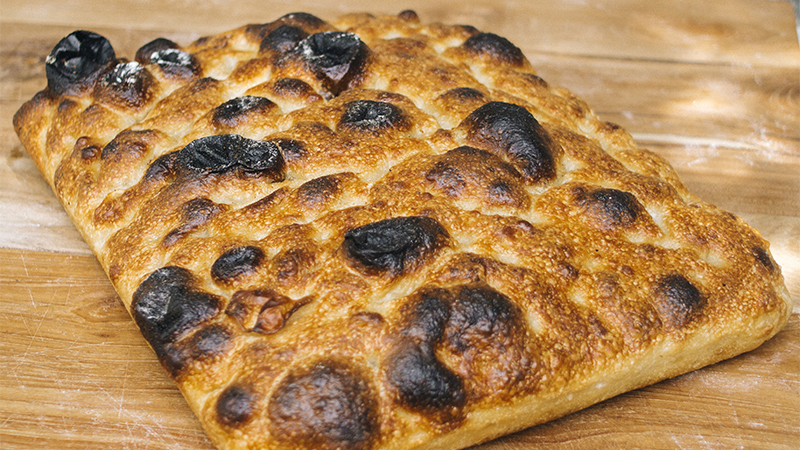Making bread doesn’t have to be super complicated! Try these recipes for a simple sourdough starter and crispy-crust sourdough focaccia that anyone can manage. Go on, give it a go!
Recipes provided by PAULO GALANG of Starter Lab Bakery in Singapore.

Recipe for Sourdough Starter
“Sourdough starter is very easy to do – anyone can manage it, with no extra equipment needed. I personally like the extra tang that the wholewheat flour contributes, but if you don’t have any, you can also use 100 percent bread flour.”
Ingredients
- 200g bread flour
- 50g wholewheat flour
Instructions
Day 1
- In a container or wide-mouth jar, hand mix 50g of flour blend with 50ml of room temperature water into a smooth paste.
- Using a rubber spatula or plastic scraper, scrape the sides clean, making sure there’s no thin dough or dry flour that might crust up.
- Cover loosely with a clean cloth and let it sit for 24 hours. The temperature should ideally be around 26°C to 28°C.

Days 2 and 3
- Remove the cover. If there are small bubbles appearing on the surface, your starter is becoming active.
- Discard half of the starter and hand mix in another 100g of flour blend and 100g of water.
- Cover loosely with a clean cloth and let it sit for another 24 hours.
- Repeat this process on the third day.
Days 4, 5 and 6
Start feeding the starter twice a day with more flour and water, and monitor its activity by checking how bubbly and active it becomes. Continue to feed the starter until it passes the following float test.
Float test:
Take a spoonful of ripe starter and put it in a bowl with water. If it easily floats, that means the starter is active and ready to be used.
Signs of a healthy starter:
A healthy starter is light, bubbly and should have a tangy acidic aroma – but not one that is unpleasant or overpowering. No liquid should form on top. “Hooch” is the liquid that collects on the surface of the starter when it hasn’t been fed in a while. The appearance of hooch indicates that the starter is hungry and needs to be fed.
Signs of a dead starter:
If the starter doesn’t respond to regular feeding, you might need to start over. If you see a pink or orange streak in your starter, that means your starter has gone bad and should be discarded.
Recipe for Sourdough Focaccia
“One of my favourite sourdough applications is focaccia as it’s super versatile. It can be enjoyed plain or as a side to any dish. The olive oil gives it the added lightness to the crumb and crispy crust with a floral aroma when it comes out of the oven. Plus, it’s baked on a tray so you don’t have to do any fancy shaping and scoring.”
Ingredients
- 365ml water (room temperature)
- 125g ripe sourdough starter (fed at least one day ahead – refer to the Starter Lab recipe on the next page)
- 500g bread flour
- 12g sea salt (plus additional for sprinkling)
- 25g extra virgin olive oil (plus additional for greasing pan)

Instructions
- In a mixing bowl, measure all ingredients except for the flour and salt.
- Hand mix until the sourdough starter is broken down into smaller pieces.
- Add bread flour and mix until there’s no more flour lumps.
- Let it rest to “autolyse” for 30 minutes.
- Finally, add in the salt and 30g of water and mix with your hands in a circular motion until the dough is a bit smooth, and cover the container with a cloth.
- Let it proof for around 1.5 hours, stretching and folding the dough twice – at the 30-minute mark and again at the one-hour mark.
- Transfer into an olive oil greased tray (on baking paper if needed).
- Let it proof at room temperature (26°C) until pillowy and roughly doubled in size (around 30 to 45 minutes).
- If baking the next day, place the tray directly in the fridge. Bring out to room temperature 30 minutes before baking. (You can keep the dough for up to two days in the fridge, as long as it’s covered properly.)
- Finish with generous splashes of olive oil and sea salt on top, and dimple the focaccia, using your fingers to sink into the dough before baking.
- Bake in a preheated 260°C degree oven for around 30 minutes.
Like this? See more great recipes in our Wine & Dine section.





